Learning Objectives
- Understand the fundamental role of computers in various daily and industrial tasks.
- Describe the basic function of a computer as an information processing system.
- Explain the significance of programmable instructions in computer versatility.
- Identify different forms and capabilities of computers across various devices.
- Recognize the universal potential of computers through appropriate programming.
1-1. Computers
In our digital era, computers have become essential to everyday life. Whether used for gaming, writing academic papers, shopping online, listening to music, or staying connected on social media, computers significantly enhance our experiences and capabilities. Beyond personal use, these adaptable devices play crucial roles in weather forecasting, airplane design, filmmaking, business operations, financial management, and industrial automation. This widespread presence raises a fundamental question: What exactly is a computer, and how does it manage such a wide range of tasks?
A computer can be briefly described as a device that processes and manipulates data according to a programmable set of instructions. This definition relies on two key points. First, computers are essentially information processing systems. They take in input data, transform it into something meaningful or useful, and then output the results for us to use or interpret. While other devices like calculators or gas pumps process information for specific tasks, such as calculating sums or measuring fuel dispensed, they lack the broad versatility of computers.
The distinguishing feature of computers is their ability to operate based on changeable programs. A program is like a recipe for the computer, a precise sequence of instructions that dictate its actions. By changing the program, we can alter the computer's behavior, allowing it to switch seamlessly from drafting documents to managing finances or entertaining us with games. This flexibility is what makes a computer a truly universal tool, capable of performing any task outlined in a program.
Computers come in various forms, including desktops, laptops, tablets, and smartphones, as well as specialized computers embedded in countless devices. A significant insight of computer science is the realization that, fundamentally, all these computers share the same capabilities. With the appropriate programming, any computer can perform the tasks of any other. This concept transforms the personal computer from a simple electronic device to a universal machine, limited only by the tasks we can envision and program. Essentially, the power of a computer lies in its ability to bring our ideas to life, making it an indispensable tool in the modern world.
1-2. Computer Programs
In the digital age, the true potential of computers is unlocked not by the hardware but by the software they run. Software, comprising the programs that guide the hardware, is the essence of any computer system. Without it, even the most advanced machines are mere intricate sculptures. This essential truth highlights the importance of programming—the process of creating software. This site is dedicated to programming, a skill that, while challenging, is accessible to anyone with determination and a willingness to learn. Programming is not just for aspiring computer scientists or tech industry professionals.
In a world where computers are integral to daily life, understanding programming demystifies these powerful tools, providing deeper insights into their capabilities and limitations. It transforms users from passive operators to architects of their digital experiences. Whether you want to enhance your computer skills or create your own applications, programming opens up a realm of possibilities. Beyond practical uses, programming fosters creativity and problem-solving. It can be both enjoyable and fulfilling, offering a way to create solutions that are functional and sometimes artistically compelling. Many find joy in programming as a hobby, while others use these skills to tackle complex problems by breaking them down into manageable parts.
The ability to think like a programmer—to understand both the system as a whole and its intricate details—is valuable across many fields. The demand for skilled programmers has never been higher, providing a path to rewarding careers for people from all educational backgrounds. Even those from unrelated fields have discovered that programming skills can lead to exciting opportunities. In the business world, where computers are central, programming knowledge can give you a competitive edge.
With these skills, you might even create the next groundbreaking application. As we explore programming, remember that this journey is about more than just learning to code. It's about gaining the tools to navigate and shape the digital world, turning ideas into reality, and unlocking the full potential of technology. Welcome to the transformative world of programming, where your imagination is the only limit.
1-3. What is Computer Science?
Computer science extends far beyond the study of computers, akin to how astronomy surpasses merely observing through telescopes. Edsger Dijkstra, a prominent figure in the field, famously likened computers in computer science to telescopes in astronomy—tools rather than the core focus. The essence of computer science delves into the processes that can be described and executed, exploring the limits of computation. The central pursuit of computer science is to discover the boundaries of what can be computed.
To achieve this, computer scientists focus on three main activities: designing, analyzing, and experimenting with algorithms. Algorithms, or sequences of steps to solve problems, are fundamental to computer science, much like recipes are to cooking. Creating and refining these algorithms form a significant part of the discipline, providing concrete solutions and demonstrating what is computable.
However, design alone has its limitations. While it can confirm the computability of tasks for which algorithms are crafted, the lack of an algorithm does not necessarily mean a problem is unsolvable—it might simply indicate that a solution has yet to be discovered. This is where mathematical analysis of algorithms comes in, assessing the solvability or practical feasibility of problems. Through analysis, computer science has identified problems that resist algorithmic solutions or are too complex for practical use.
When problems elude straightforward analysis or are too ambiguous, experimentation is essential. Computer scientists develop systems to test theories in the real world, observing and refining based on performance. This empirical approach validates and enhances theoretical analyses and is crucial for creating functional, reliable technologies.
Yet, computer science is not limited to algorithms. It encompasses various fields where computing plays a pivotal role, such as mobile computing, networking, artificial intelligence, and more. It influences diverse areas including human-computer interaction, computational science, data management, software engineering, and cybersecurity. In each domain, computer science principles drive innovation, solve problems, and improve our interaction with technology.
In our modern society, where technology permeates every aspect of life, computer science is fundamental. It provides us with the tools and knowledge to navigate and shape the digital world. Through computer science, we can transform ideas into reality, continually pushing the boundaries of what is possible in our increasingly interconnected world.
1-4. Programming Languages
Programming languages serve as the connection between human ideas and computer actions. Ideally, we could communicate with computers using everyday language, similar to scenes in science fiction movies. Technologies like Siri, Google Now, and Cortana have made progress towards this vision, but fully comprehending human language remains a complex challenge for computers. Natural languages, rich with ambiguity and nuances, aren't precisely suited for defining the strict logic required by algorithms.
To address this, computer scientists have created programming languages—specialized notations designed to express computations clearly and without ambiguity. These languages, such as Python, C++, and Java, have strict syntax (rules of structure) and semantics (meaning), enabling programmers to write instructions that computers can execute. Coding involves using these languages to formulate algorithms in a way that computers can understand.
High-level programming languages, including the ones mentioned, are designed for human readability and ease of use, while computers operate on a much simpler, binary language known as machine language. For example, a simple addition in Python, written as c = a + b, is easy for us to understand but needs translation into the binary operations that a computer's CPU can perform.
This translation from high-level to machine language is achieved through two main processes: compiling and interpreting. A compiler converts the entire program from a high-level language (source code) into machine language (executable code) all at once, allowing the computer's hardware to execute it directly. An interpreter, on the other hand, processes the program line by line, translating and executing each instruction on the fly without producing a separate machine language program.
The key difference between these two approaches is efficiency and flexibility. Compiled programs, once translated, run quickly since they are already in the computer's native language. Interpreted languages, however, offer more flexibility during development, allowing for immediate execution and testing of code, which can speed up the programming process.
High-level languages also provide portability. Unlike machine-specific binary code, a program written in a high-level language can run on various types of computers with the appropriate compiler or interpreter. This means the same Python program could run on both a laptop and a tablet, despite differences in their hardware, because both devices have Python interpreters.
In summary, programming languages are essential tools for communicating tasks to computers, crafted to minimize ambiguity and enhance clarity. The choice between compiling and interpreting depends on the program's needs and the development process, balancing speed against flexibility and ease of debugging.
1-5. Discovering Python
In the digital age, the pursuit of efficiency and innovation often leads to the automation of mundane or complex tasks. Whether it's managing large datasets, organizing photos, developing games, or creating specialized applications, the need for a powerful and versatile programming tool is clear. This is where Python comes in, a language inspired by the whimsical world of "Monty Python's Flying Circus," not the reptile.
Python is more than just another programming language; it's designed to simplify your life. Imagine needing to automate file management, text manipulation, or create a custom database or user-friendly GUI application. While traditional scripting or programming languages can accomplish these tasks, they often do so at the expense of time and simplicity. Python, with its elegant syntax and powerful features, makes these tasks more accessible and enjoyable.
For professionals used to the rigorous development process of C/C++/Java, which involves writing, compiling, testing, and debugging, Python offers a refreshing alternative. Its interpreted nature allows for immediate testing of ideas and building functionalities without the long wait times of compilation. Whether refining a test suite, extending an application, or experimenting with new algorithms, Python enhances productivity and fosters creativity.
Why Python Stands Out
- Simplicity and Efficiency: Python's syntax is designed for clarity and simplicity, making it an excellent choice for beginners and experts alike. Its high-level data types allow for expressive code that can perform complex operations succinctly. Python encourages readable and maintainable code, with indentation replacing the clutter of brackets and no need for variable declarations.
- Versatile Toolset: With Python, you're not just learning a language; you're gaining access to an extensive ecosystem of standard modules and packages. These tools can serve as the foundation for virtually any project, from web development and data analysis to automation and scientific computing. Plus, the community-contributed packages further expand Python's capabilities into specialized fields.
- Interactive Development: Python's interpreter supports interactive modes, offering an exploratory coding environment. This feature is invaluable for learning, experimenting, and debugging, allowing for real-time feedback and adjustments.
- Extensibility: For those who know C, extending Python with new functionalities or connecting it to existing libraries is straightforward. This extensibility makes Python not just a language for application development but a platform for integrating and enhancing other software components.
- Cross-Platform Compatibility: Python runs on Windows, macOS, and Unix systems, ensuring your projects can reach the widest possible audience.
As we embark on this journey through Python's landscape, we encourage you to engage with the language actively. The best way to learn Python is by using it: experiment, build, break, and rebuild. Our tutorial modules are designed to introduce Python's fundamentals through hands-on examples and practical exercises, starting from basic expressions and data types to advanced concepts like exceptions and custom classes.
By the end of this exploration, you'll not only have a solid understanding of Python but also the skills to harness its potential for your projects, whether they're personal, professional, or purely exploratory. Welcome to the world of Python programming—where creativity meets capability.
1-6. Setting Up Python Windows and macOS
Embarking on your Python programming journey begins with setting up the environment on your computer. This guide will walk you through installing Python on Windows and macOS, ensuring you are ready to dive into the world of programming with minimal fuss.
1.6.1. Installing Python on Windows
- Download the Installer:
Visit the official Python website (python.org) and navigate to the Downloads section. The website should automatically offer you the latest version of Python for Windows. Click on the download link for the Windows installer.
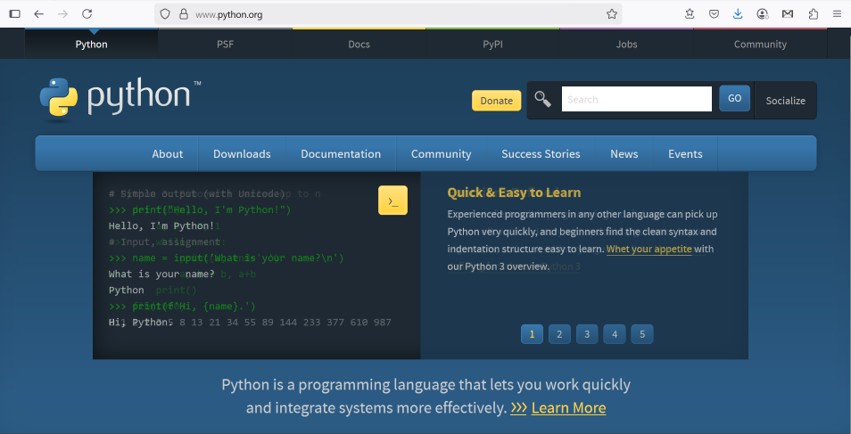
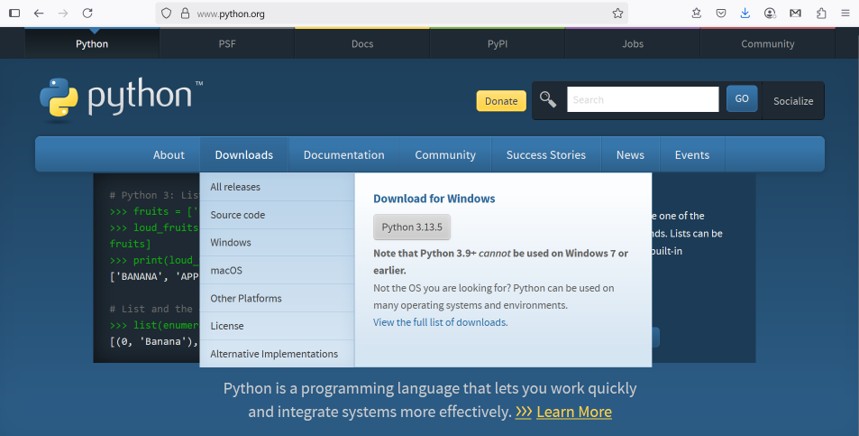
- Run the Installer:
Once the installer is downloaded, locate it in your downloads folder and double-click to run it. You will be greeted with the installation window.

Important: Ensure you check the box that says "Add Python.exe to PATH" before clicking "Install Now." This step is crucial as it makes Python accessible from the Command Prompt.
- Customize Installation (Optional):
For most users, the default installation options will suffice. However, if you need to customize locations or configurations, you can click on “Customize installation” and adjust the settings accordingly.
- Complete the Installation:
Follow the on-screen instructions to complete the installation. Once finished, you will see a screen with a message saying, “Setup was successful.” Click "Close" to finish the setup process.
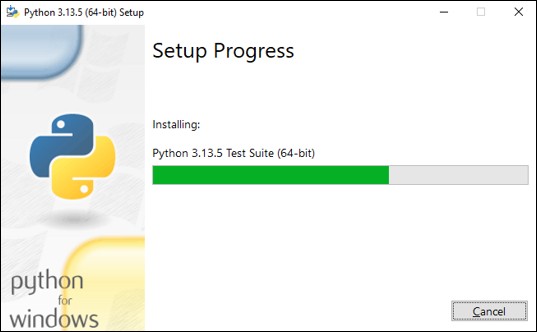
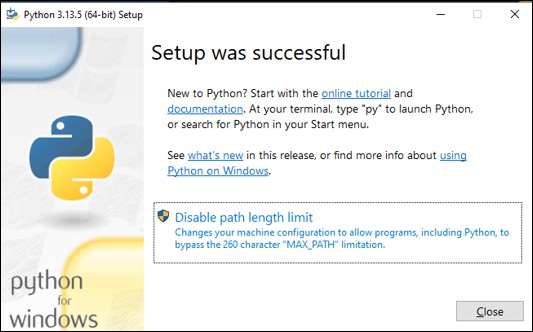
1.6.2. Installing Python on macOS
- Download the Installer:
Head to the official Python website (python.org) and click on the Downloads tab. The site should automatically suggest the latest version of Python for macOS. Download the macOS installer.
- Run the Installer:
Open the downloaded package and follow the installation wizard. The wizard will guide you through the necessary steps, including agreeing to the license agreement and selecting an install location.
- Install Python:
Continue through the installer's steps and click "Install" to begin the installation process. You may need to enter your administrator password to authorize the installation.
- Complete the Installation:
Once the installation is complete, you will see a confirmation screen. Click "Close" to exit the installer.
1.6.3. Verifying Python Installation
After installation, it is crucial to verify that Python is correctly installed and accessible from your system's command line or terminal.
On Windows:
- Open Command Prompt by typing cmd in the search bar and pressing Enter.
- In the Command Prompt, type python --version and press Enter. If Python is correctly installed, you should see the version number displayed.
On macOS:
- Open Terminal by going to Applications > Utilities > Terminal.
- Type python3 --version in the Terminal and press Enter. You should see the Python version number if the installation was successful.
1.6.4. How to Use Python Shell
On Windows:
- Start the Python Shell: In the Command Prompt, type python and press Enter. You should see something like this:

- Using the Shell: The >>> prompt indicates that you are now in the Python shell. You can type Python commands directly here. For example:

- To exit the Python shell, you can type exit() or press Ctrl + Z and then Enter.
On macOS:
- Start the Python Shell: In Terminal, type python3 and press Enter. You should see something like this:

- Using the Shell: The >>> prompt indicates that you are now in the Python shell. You can type Python commands directly here. For example:

- To exit the Python shell, you can type exit() or press Ctrl + D.
1.6.5. Installation of Visual Studio Code
After installing Python, an editor is needed to write and run Python codes.
Installation on Windows:
- Download Visual Studio Code
- Go to the Visual Studio Code website.
- Click on the "Download" button for Windows.
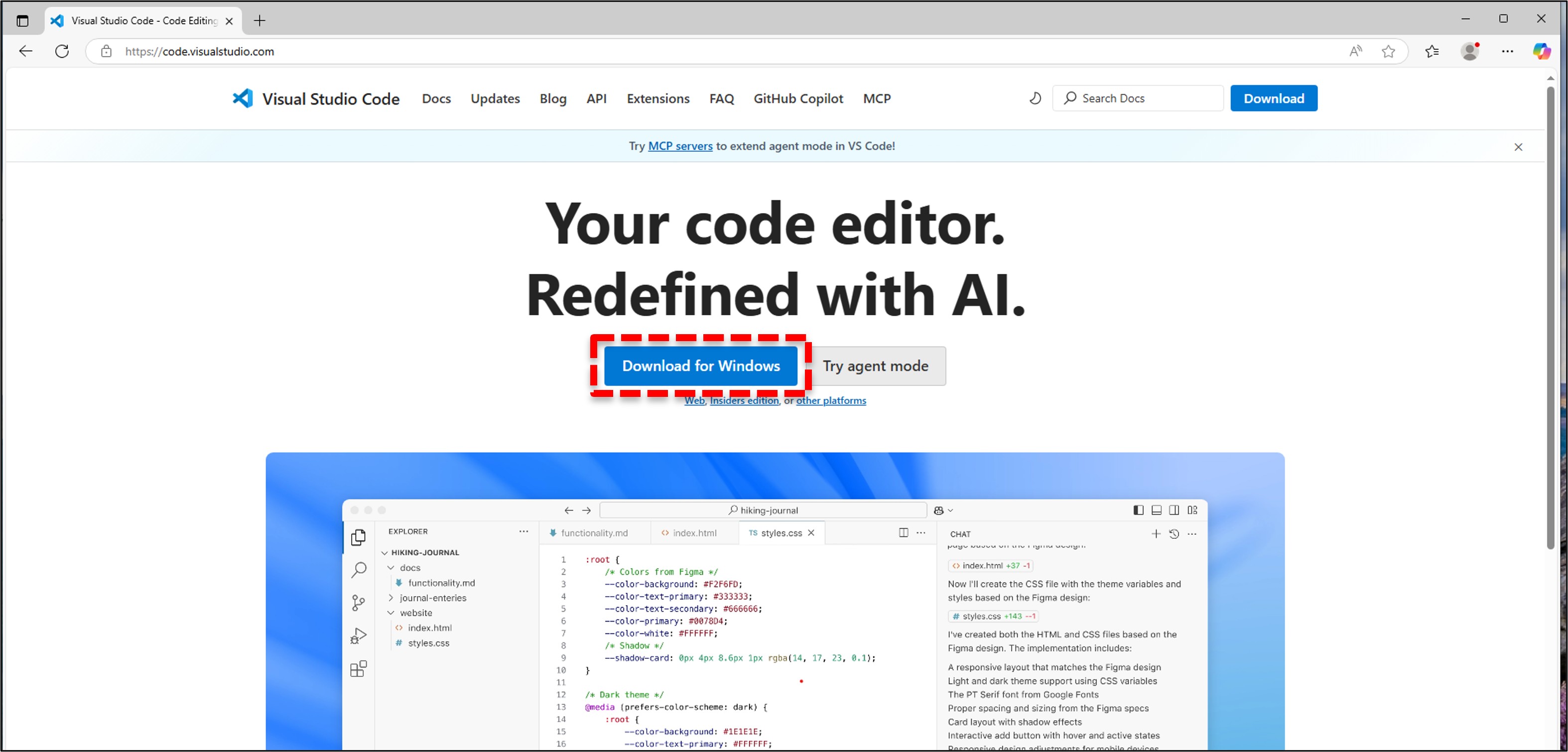
- Install Visual Studio Code
- Once the download is complete, open the installer file.
- Follow the setup instructions: accept the agreement, choose the installation location, and select additional tasks (e.g., creating a desktop icon).
- Click "Install" and wait for the installation to complete.
- Once installed, launch Visual Studio Code.
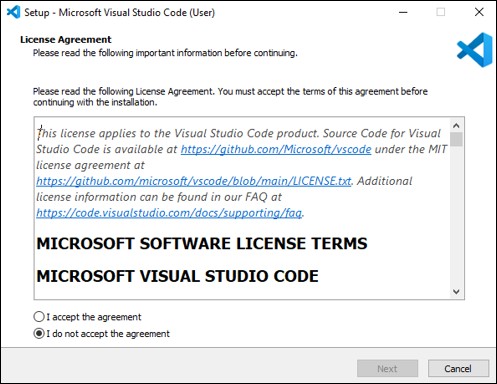
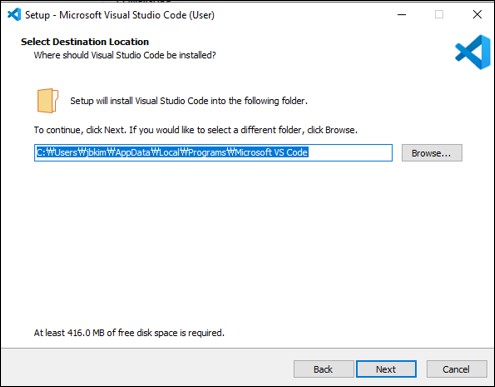
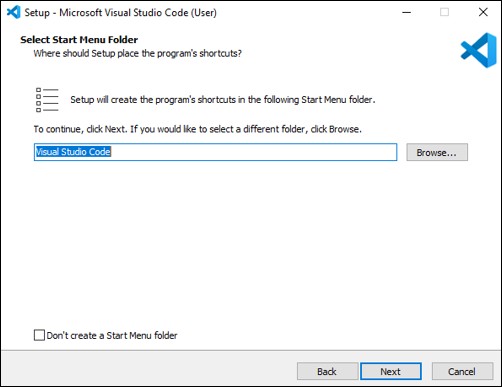



On macOS:
- Download Visual Studio Code
- Go to the Visual Studio Code website.
- Click on the "Download" button for macOS.
- Install Visual Studio Code
- Once the download is complete, open the .dmg file.
- Drag the Visual Studio Code app to the Applications folder.
- Launch Visual Studio Code from the Applications folder.
1.6.6. Setting Up Python in Visual Studio Code
After installing Visual Studio Code, Python Extension for Visual Studio Code is needed.
- Open Visual Studio Code.
- Go to the Extensions view by clicking the Extensions icon in the Activity Bar on the side of the window or by pressing Ctrl+Shift+X (Windows) or Cmd+Shift+X (macOS).
- Search for "Python" and click "Install" on the extension provided by Microsoft.
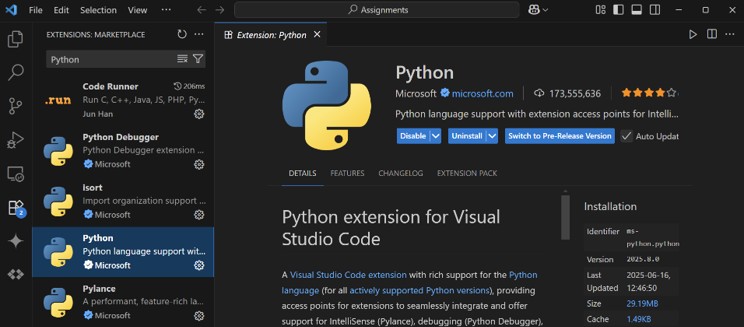
1.6.7. Running Python Code Using Command Prompt (Windows)
- Open Command Prompt
- Press Win+R, type cmd, and press Enter.
- Navigate to the Python Script Directory
- Use the cd command to navigate to the directory where your Python script is located. For example:
cd path\to\your\script
- Run the Python Script
- Execute your Python script by typing:
python your_script.py
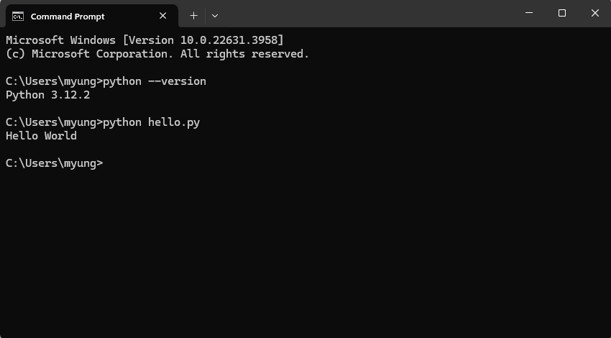
1.6.8. Running Python Code Using Terminal (macOS)
- Open Terminal
- Press Cmd+Space to open Spotlight Search, type Terminal, and press Enter.
- Navigate to the Python Script Directory
- Use the cd command to navigate to the directory where your Python script is located. For example:
cd path\to\your\script
- Run the Python Script
- Execute your Python script by typing:
python3 your_script.py
1.6.9. Running Python Code in Visual Studio Code
- Open Visual Studio Code
- Launch Visual Studio Code.
- Open Your Python Script
- Open the file containing your Python script by navigating to File > Open File and selecting your script.
- Run the Python Script
- Open the integrated terminal by selecting View > Terminal.
- Ensure the terminal is in the correct directory or navigate using the cd
- Type the following command to run your script:
python your_script.py
-
- Alternatively, you can run the script by clicking the "Run" button provided by the Python extension.
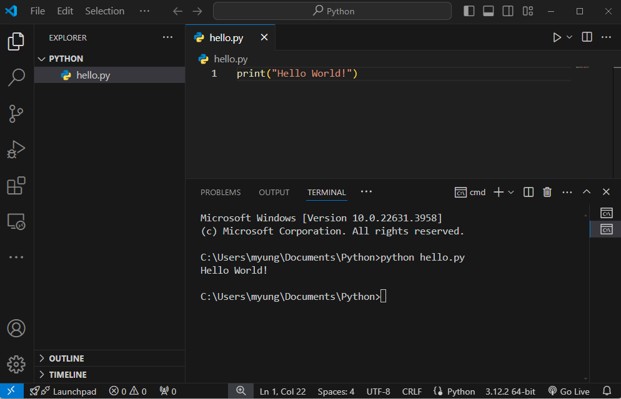
1.7 Hardware
Hardware refers to all the physical, tangible parts of a computer system. Unlike software (which is a set of instructions), hardware is what you can touch—wires, chips, screens, keyboards, and more.
A computer system is made up of multiple components that work together to process data, store it, and communicate results to the user. These components are often categorized by their role in the computing process.
1.7.1. Major Components of a Computer System
- Central Processing Unit (CPU)
- The Brain of the Computer
- Main Memory (RAM)
- Short-term Memory
- Secondary Storage Devices
- Long-term Storage
- Input Devices
- Getting Data Into the Computer
- Output Devices
- Getting Results Out of the Computer
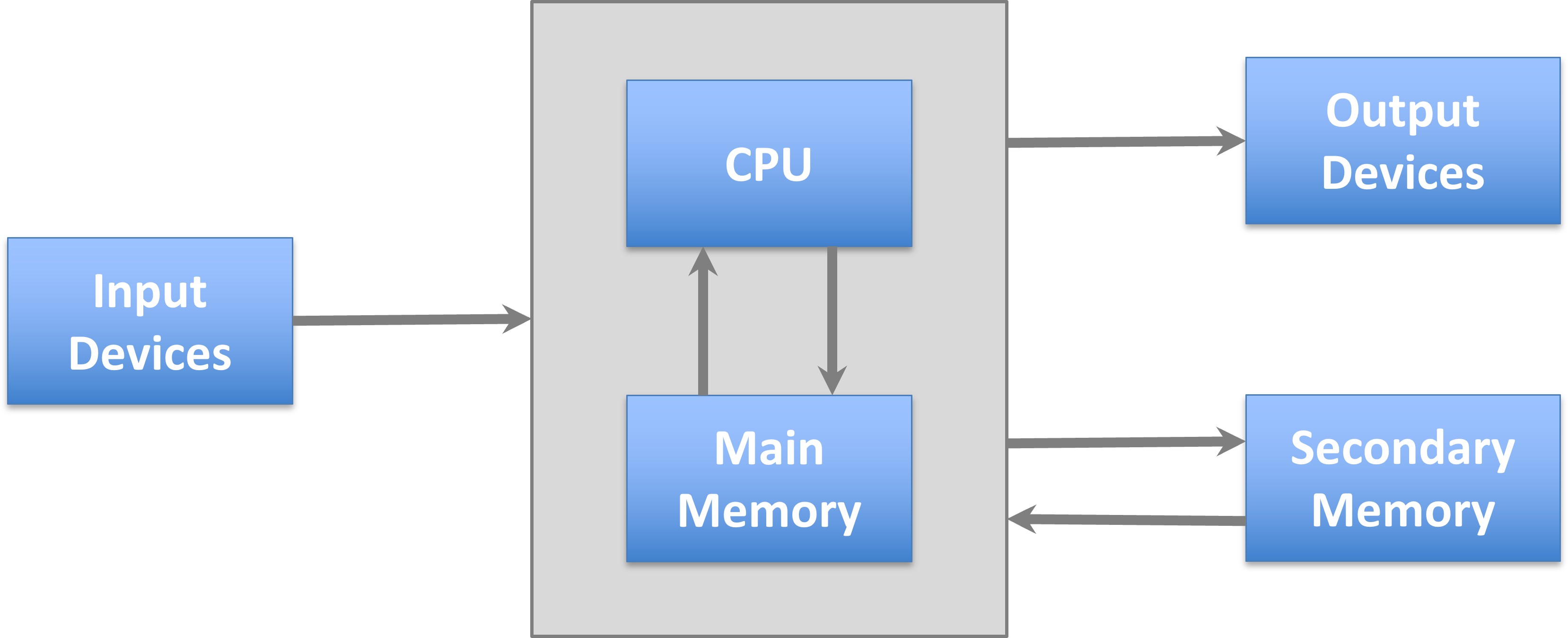
1.7.2. Central Processing Unit (CPU) - The Brain of the Computer
- Role: Executes instructions and controls the overall operation of the computer.
- Parts of CPU:
- Control Unit (CU): Directs the flow of data and instructions.
- Arithmetic Logic Unit (ALU): Performs arithmetic (addition, subtraction, etc.) and logic operations (comparisons, conditions).
- Function: Fetches instructions from memory, decodes them, and executes them.
1.7.3. Main Memory (RAM) - Short-term Memory
- RAM = Random Access Memory
- Role: Temporarily stores data and instructions that the CPU is currently using.
- Volatile: Contents are lost when the computer is turned off.
- Fast but limited: Used for running programs, not for long-term storage.
1.7.4. Secondary Storage Devices - Long-term Storage
- Used to permanently store data and programs.
- Slower than RAM but retains data even when the power is off.
- Examples:
- Hard Disk Drives (HDD)
- Solid State Drives (SSD)
- USB flash drives
- CDs/DVDs
1.7.5. Input Devices - Getting Data into the Computer
- Allow the user to enter data and commands.
- Examples:
- Keyboard
- Mouse
- Scanner
- Microphone
- Touchscreen
1.7.6. Output Devices - Getting Results Out of the Computer
- Display or output the results of the computer’s processing.
- Examples:
- Monitor (displays text and images)
- Printer (outputs hard copies)
- Speakers (output sound)
1.8 Software
Software: The instructions that control a computer
- Unlike hardware, software is not physical—it consists of the programs and instructions that tell a computer what to do.
- Everything a computer does—from displaying a webpage to printing a document—is controlled by software.
- Without software, hardware alone is useless.
- Software provides the logic, control, and interaction between the user and the computer’s physical components.
1.8.1. Categories of Software
- Application Software, System Software
1.8.2. Application Software - Helps users perform specific tasks
- Application software is designed to make the computer useful for everyday activities.
- Examples:
- Word processors (e.g., Microsoft Word)
- Email clients (e.g., Outlook)
- Web browsers (e.g., Chrome, Firefox)
- Games
- Spreadsheet programs (e.g., Excel)
- Media players (e.g., VLC)
1.8.3. System Software - Controls and manages the computer itself
- System software manages the hardware and provides a platform for application software to run. It operates behind the scenes to keep the system running smoothly.
- Components of System Software:
- Operating System (OS):
- Manages hardware (CPU, memory, I/O devices)
- Coordinates between hardware and software
- Provides user interfaces and file management
- Examples: Windows, macOS, Linux, Android
- Utility Programs:
- Perform specialized maintenance tasks to improve performance or protect data.
- Examples: Antivirus software, Disk cleanup tools, Backup utilities, etc.
- Operating System (OS):
1.8.4. How a Program Works
- At its core, a program is a set of instructions that tells the CPU what to do.
- These instructions guide the computer through tasks like performing calculations, making decisions, or managing data.
- Examples of Simple CPU Operations
- The CPU performs operations one small step at a time. Here are some basic tasks it can do:
- Reading data from memory, Storing data to memory, Adding numbers, Subtracting numbers, Multiplying or dividing, Comparing values, Jumping to another instruction
- The CPU performs operations one small step at a time. Here are some basic tasks it can do:
- Machine Language and the Instruction Set
- The CPU only understands machine language: a very low-level language made up of binary code (0s and 1s).
- Each operation the CPU can perform is represented by a specific machine instruction.
- Instruction Set
- Each brand or type of CPU (e.g., Intel, AMD, ARM) has its own unique instruction set, which is a list of all the basic commands that CPU can execute.
- Examples of instructions in an instruction set:
- ADD A, B (add value in B to value in A)
- MOV A, 5 (store number 5 into memory location A)
- Note: Higher-level languages (like Python or Java) are eventually translated into this low-level machine code so the CPU can understand and execute them.
1.8.5. Cycle of Operation (Fetch-Decode-Execute Cycle)
- Every instruction goes through three key steps:
- Fetch: CPU reads the next instruction from memory.
- Decode: CPU interprets what the instruction means.
- Execute: CPU carries out the instruction.
- This cycle repeats millions to billions of times per second in modern processors.

1.8.6. Machine Language
- Machine language is the lowest-level programming language made up entirely of binary numbers (0s and 1s).
- Each instruction is a long series of bits that the CPU understands directly.
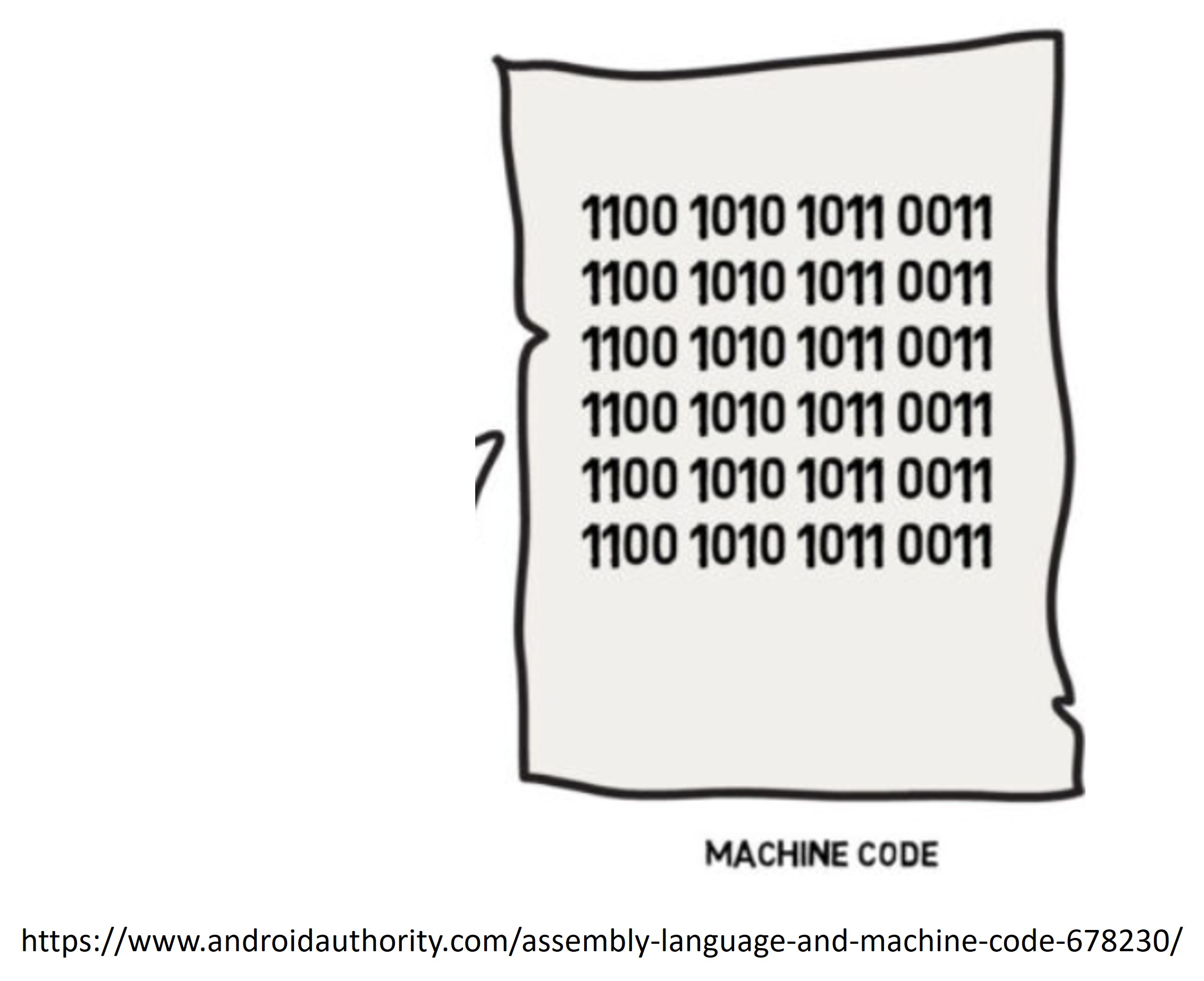
- Problems with Writing in Machine Language:
- Difficult to read and write (e.g., 10110000 01100001)
- Hard to debug and maintain
- Tedious and error-prone
- Not portable — different CPUs have different machine languages
1.8.7. Assembly Language
- To make programming easier, developers created assembly language.
- What is Assembly Language?
- A low-level programming language that uses mnemonics (short, readable words) instead of binary numbers.
- Each assembly instruction maps one-to-one with a machine instruction.
- Example


1.9 High-Level Language
High-Level Language: A high-level language is a programming language that allows developers to write powerful and complex programs using code that is easy for humans to read and write.
- Key Characteristics of High-Level Languages
-
- Easier to Use and Understand: Uses English-like words and logical structures (e.g., if, while, print)
- Abstracts Away Hardware Details: You don’t need to know how the CPU or memory works
- Fewer Instructions Needed: A single line of high-level code can represent dozens or hundreds of machine instructions
1.9.1. Compilers and Interpreters
- To run a high-level program, it must be translated into machine language using a compiler or interpreter
1.9.2. Compiler: Translation Before Execution
- A compiler is a special program that translates an entire high-level program into machine language before the program is run.
- The result is a separate machine language file (called an executable), which can then be run any time without needing the original source code or the compiler.
- Key Features:
- Fast execution after compilation, Error checking happens before running, Produces a standalone file
- Example: Languages that use a compiler
- C, C++, Java (compiled to bytecode), etc.
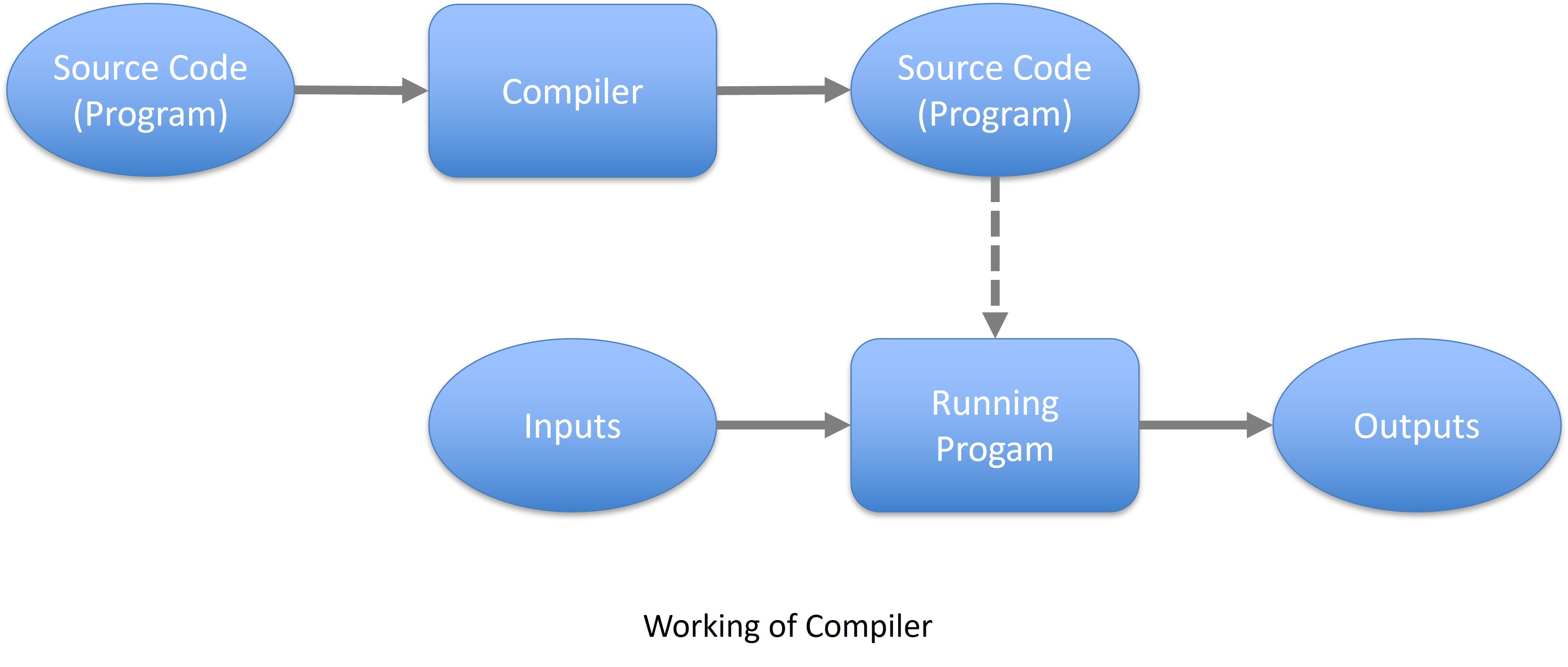
1.9.3. Interpreter: Translation During Execution
- An interpreter translates and runs the high-level program one instruction at a time.
- It does not produce a separate machine language file.
- Every time you run the program, the interpreter must reprocess the source code.
- Key Features:
- Easier to test and debug during development
- Slower execution compared to compiled programs
- No need for a separate compilation step
- Example: Languages that use an interpreter
- Python, JavaScript, Ruby, etc.

1.9.3. Compling vs. Interpreting
- Once program is compiled, it can be executed over and over without the source code or compiler.
- If it is interpreted, the source code and interpreter are needed each time the program runs

Summary
- Computers are essential in everyday life, used for gaming, writing, shopping, music, and social media.
- They play crucial roles in weather forecasting, airplane design, filmmaking, business operations, financial management, and industrial automation.
- A computer processes and manipulates data according to programmable instructions.
- Computers are information processing systems that transform input data and produce output for use or interpretation.
- Unlike other devices that process specific tasks, computers have broad versatility due to their programmable nature.
- Programs are precise sequences of instructions that dictate a computer's actions, allowing for a wide range of tasks.
- Changing programs can alter a computer's behavior, making it a universal tool.
- Computers come in various forms, including desktops, laptops, tablets, smartphones, and specialized devices.
- All computers share fundamental capabilities, enabling any computer to perform any task with appropriate programming.
- The power of computers lies in their ability to bring ideas to life, making them indispensable tools in the modern world.